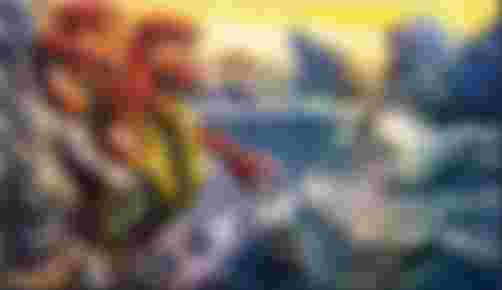According to the beliefs of the ancient Greeks, two terrible monsters were located on both sides of the Strait of Messina and which did not allow any ship to pass unscathed.
Scylla is the immortal sea monster, Krataja's birth. She lived in a cave below a smooth high ridge, the tops of which were covered with eternal mists. It has twelve legs and six very long necks, with horrible heads, on which are three rows of teeth. Perhaps the most unusual thing about Scylla is her barking; he is no stronger than the whining of a newborn puppy. It is hidden in a cave up to half of its body, and it hunts with its heads everything that moves in the sea and on its surface. Each ship paid tribute to her; Scylla used to catch sailors (one for each of her six heads) and transfer them to the rocks, where she broke their bones and ate them tightly. As Odysseus' ship passed by Scylla's cave, Odysseus, on the advice of the sorceress Kirke, sacrificed six of his companions to her, so that they would not all become the prey of the even more terrible Charybdis.
In a later legend, Scylla is imagined as a creature with the face and chest of a woman, who has six heads and twelve dog legs on the sides. Fork and Hecate, Typhon and Echidna or Crateida and Trien are mentioned as her parents, and some say that she is Lamia's child. It was believed that Scylla was at first a beautiful girl, loved by Glaucus, Poseidon's son. When she refused his love, he sought help from the sorceress Kirke, who herself loved Glaucus. Jealous of his love for Scylla, Kirka put powerful herbs and poison on the place where Scylla bathed. When the unfortunate girl stepped into the water up to her waist, she noticed a terrible dog's head around her thighs; in fear, she went ashore and only then did she realize that the heads of hellish animals were part of herself.
Others say that Scylla loved Poseidon and that the jealous Amphitrite, his wife, turned that beautiful girl into a dog-like monster with six scary heads and twelve dog legs. According to the Italian-Sicilian tradition, Scylla was killed by Hercules when she kidnapped one of Gerion's cattle. The sea god Fork, Scylla's father, assembled his daughter's body with lighted torches and revived it.

Charybdis is a monster that resides under a rock on which grows a large fig tree, and is far from another monster - Scylla - within range of an arrow. With a terrible echo, Charybdis sucked a huge amount of sea water three times a day and expelled it three times, swallowing everything in it. Even the god of the sea, Poseidon, could not help the ships approaching Charybdis; because of that, the sorceress Kirk advised Odysseus to pass Scylla with her ships, which is less scary. After the shipwreck, Odysseus was thrown to Charybdis on the log of a wrecked ship, at the moment when she was drawing water into herself. He was saved only by his ingenuity; he held fast to the large fig tree, until Charybdis threw out the parts of the ship, on which he continued his journey to the island of Ogygia. On their return from Colchis, where they obtained the golden fleece, the Argonauts managed to pass by Charybdis happily only thanks to the help of Thetis and her sisters. On his way to Italy, after escaping from war-torn Troy, Aeneas escaped Charybdis by sailing around Sicily.
Charybdis and Scylla were believed to live in the Strait of Messina, below Mount Pelora. According to a later legend, Charybdis is the extremely voracious daughter of Poseidon and Gaia. When Hercules passed by her with Gerion's cattle, she stole and devoured his cattle. Zeus punished Charybdis with a lightning strike and threw her into the sea, but she still remained very voracious.
Literature:
• Dragoslav Srejović - Aleksandrina Cermanović-Kuzmanović, Recnik grčke i rimske mitologije, drugo izdanje, Beograd: Srpska književna zadruga, 1987

This is one of my favorite stories from Greek mythologie. Thank you for writting here about this.